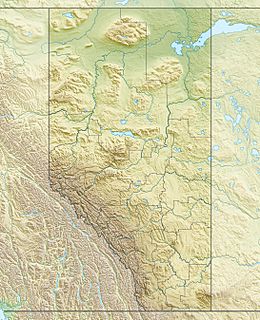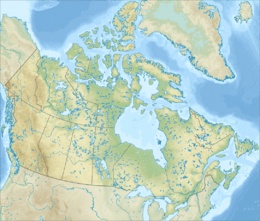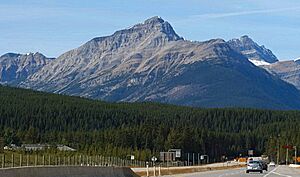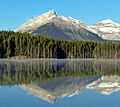Mount Bosworth facts for kids
Quick facts for kids Mount Bosworth |
|
|---|---|
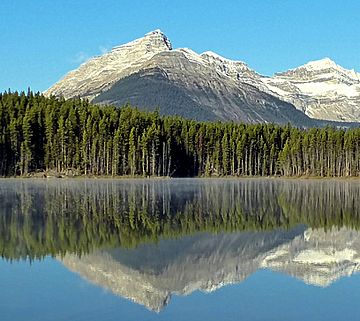
Mount Bosworth reflected in Herbert Lake
|
|
| Highest point | |
| Elevation | 2,769 m (9,085 ft) |
| Prominence | 159 m (522 ft) |
| Geography | |
| Location | Alberta / British Columbia |
| Parent range | Park Ranges Canadian Rockies |
| Topo map | NTS 82N/08 |
| Climbing | |
| First ascent | 1903 Dominion Topographic Survey |
| Easiest route | Scrambling Routes |
Mount Bosworth is a tall mountain found in the Canadian Rockies. It sits right on the border between the provinces of Alberta and British Columbia. You can find it just northwest of a famous mountain pass called Kicking Horse Pass. This mountain is also special because it's part of two big national parks: Banff National Park in Alberta and Yoho National Park in British Columbia.
The mountain was named in 1903 after George Morris Bosworth. He was an important person who worked for a very long time at the Canadian Pacific Railway, which built railways across Canada.
How Mount Bosworth Was Formed
Mount Bosworth is made up of a type of rock called sedimentary rock. This kind of rock forms over millions of years from layers of sand, mud, and tiny bits of plants and animals that settle at the bottom of ancient seas.
The rocks that make up Mount Bosworth were laid down during very old time periods, from the Precambrian era (which was billions of years ago!) to the Jurassic period (when dinosaurs roamed the Earth). Imagine these layers forming in shallow seas long, long ago.
Later, a huge event called the Laramide orogeny happened. This was a time when massive forces deep within the Earth pushed and folded the land. During this event, the older sedimentary rock of Mount Bosworth was pushed up and over younger rocks, creating the mountain we see today. It's like a giant slow-motion collision that built up the mountains.
Weather and Climate
Mount Bosworth has a subarctic climate. This means it has very cold winters with lots of snow, and summers that are usually mild, not too hot.
Temperatures on the mountain can drop below −20 °C (which is −4 °F). When you add in the wind chill, which makes it feel even colder because of the wind, temperatures can feel like they are below −30 °C (−22 °F). So, it's a very chilly place in winter!
Images for kids


